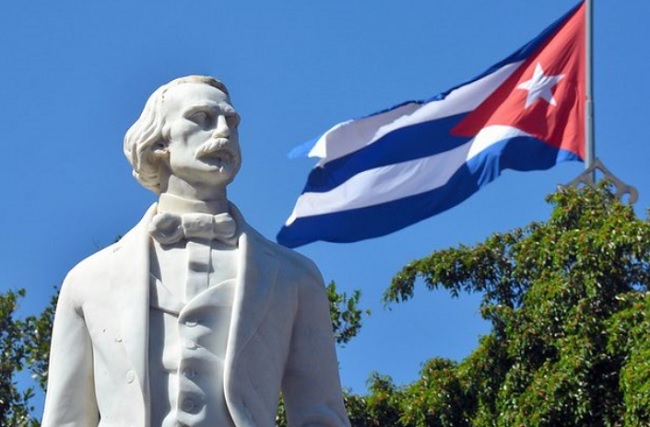
Carlos Manuel de Céspedes, the patrician who illuminated the path to independence
In Havana, in its Plaza de Armas, the oldest of those existing in Cuba today, a monument erected in homage to Carlos Manuel de Céspedes, the Father of the Nation, who was the one who led on October 10, 1868 at his Demajagua mill to the group of patriots who started the war for the independence of Cuba.
The white marble statue, the work of Sergio López Mesa, was unveiled and placed there on February 27, 1955, coinciding with the 81st anniversary of the fall of Carlos Manuel de Céspedes in a sustained confrontation with forces at the service of Spain in the eastern zone of San Lorenzo.
Placing the statue of Céspedes in the central area of the Plaza de Armas generated a debate in which Dr. Emilio Roig, Director of the Office of the City Historian, played an essential role, who vehemently defended the idea of paying homage to Lawns in the Cuban capital.
In Havana then there was only a modest monument to Céspedes
At the Instituto de la Víbora, a work that was due to the initiative of the outstanding professors and historians Hortensia Pichardo and Fernando Portuondo. They worked in that student center.
The placement of the statue of Céspedes in the central part of the Plaza de Armas entailed the removal of that of the Spanish King Fernando VII from that site, but it was not destroyed, but rather kept in the old Palace of the General Captains.
 Years later, when Dr. Eusebio Leal, continuator of the work carried out by Dr. Roig at the head of the Historian's Office, faced the remodeling of the Plaza de Armas, it was decided not to restore the statue of Fernando VII in the central part where it had already been It was a tradition that the one in Céspedes was there, but it did turn out to be placed in a corner of the aforementioned square.
Years later, when Dr. Eusebio Leal, continuator of the work carried out by Dr. Roig at the head of the Historian's Office, faced the remodeling of the Plaza de Armas, it was decided not to restore the statue of Fernando VII in the central part where it had already been It was a tradition that the one in Céspedes was there, but it did turn out to be placed in a corner of the aforementioned square.
Born on April 18, 1819 in the city of Bayamo, Carlos Manuel de Céspedes is one of the most relevant figures in the history of Cuba.
A few years after his birth, Céspedes' parents moved to a family country estate. There he spends the first five years of his life. After returning to Bayamo he completed his primary and secondary education. Taking into account the economic possibilities of his family, he later moved to Havana to study at the university.
For three years the young man devoted himself entirely to mastering the different subjects at the Real y Conciliar Colegio Seminario de San Carlos.
On March 22, 1838, he obtained a Bachelor's degree in Civil Law from the Royal and Pontifical University of Havana.
In the month of July 1840 he left Céspedes for Spain. The stay of the young student in the agitated and turbulent Catalonia is decisive for his future political life. After completing his law studies, he traveled to various European countries, as well as Turkey and some regions of the empire of the Russian tsars. He returns to Cuba in 1844 and in Bayamo he opens a law firm.
As early as 1867 he began to conspire in Manzanillo together with Francisco Vicente Aguilera and Pedro, Perucho, Figueredo. He later founded and presided over the Revolutionary Junta of said city.
In December 1867, the governor of Manzanillo received an anonymous letter, in which he was warned of a projected conspiracy against the government and that the cry was going to be given on Christmas Eve, detailing the name of Carlos Manuel de Céspedes.
The governor of Bayamo decided to arrest Céspedes, but he did not do so because he was found at the bedside of his seriously ill wife. When his wife died, at the beginning of 1868, Carlos Manuel moved to the Demajagua sugar mill. It seemed that his greatest interest consisted in attending to and achieving the development of that farm owned by him. But in reality he kept thinking more about carrying out the war for the liberation of Cuba from Spanish colonial rule.
In a meeting held on August 4, 1868, Céspedes unsuccessfully defended the criterion of starting the war against Spain immediately, considering that the conditions for it existed. However, later on October 6, 1868, at the Ingenio Rosario, he was elected head of the armed uprising, which was agreed to start on October 14, 1868.
Knowing that on the 8th they had sent a telegram to the military governor of Bayamo ordering his arrest and that of the main conspirators, he urged the patriots who supported him to concentrate on his sugar mill on the night of October 9 .
The next morning through the sound of the bell in a vibrant way he calls his slaves, not to carry out a day of work but to give them their freedom and invite them to support him in the war for the independence of Cuba.
On the centenary of the beginning of the war for independence, the maximum leader of the Cuban Revolution, Fidel Castro, affirmed when assessing the attitude of Carlos Manuel de Céspedes at that crucial moment: "It is unquestionable that Céspedes had the clear idea that that The uprising could not wait too long nor could it risk going through the long process of a perfect organization, an armed army, large quantities of weapons, to start the fight, because in the conditions of our country at that time it was extremely difficult. And Céspedes had the decision.”